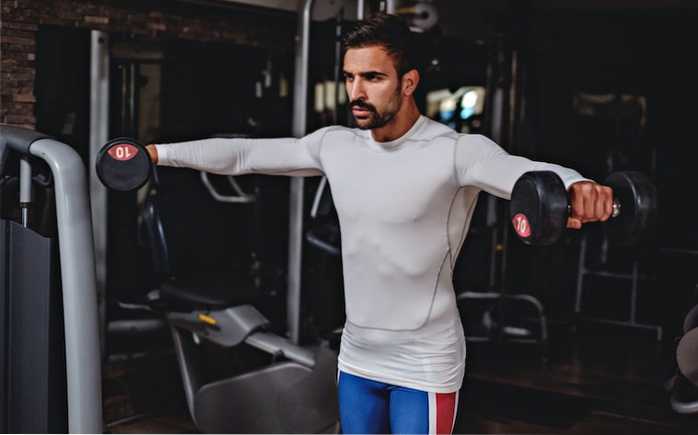
5 Lateral Raise Variations For Bigger Delts

Bigger shoulders have probably been on your training wish list since you picked up your first dumbbell in high school. Broad shoulders not only help you look strong, but a stronger pair of delts can help to fix poor posture (and the aches that come with it) and improve your joint stability and mobility. If you're reading this article now wondering why you don't have bigger shoulders (and realizing that you're hunching over), we have a fix: lateral raises.
Yes, lateral raises - that simple exercise that has you hold a pair of dumbbells and raise your arms from your sides. The lateral raise targets your lateral, or medial, deltoid to create that rounded, sculpted look.
Editor's note: This article is an op-ed. The views expressed herein and in the video are the author's and don't necessarily reflect the views of BarBend. Claims, assertions, opinions, and quotes have been sourced exclusively by the author.

When it comes to most isolation exercises like the lateral raise, creating and maintaining tension is paramount. If you don't feel the muscle working while you do lateral raises, then chances are it's not. One issue could be that your form is wrong, and another could be that you're using too much weight. Either way, one the five variations on this list may be the lateral raise tweak you need to reap the benefits of this tried-and-true move.
5 Lateral Raise Variations
Here are five variations to help build those boulder shoulders and all the benefits that come with them.
1. Wall Press Lateral Raise
Simultaneously pressing one hand into the wall while performing a lateral raise with your other arm creates more tension in both shoulders through a process called irradiation. Being against the wall, you're less likely to cheat the weight up as doing so would feel very awkward.
You'll notice in the video below that my left side is essentially flush against the wall:
You will still feel tension against the left side, which comes from a need to stabilize as you move the weight - that's normal. When you try this, remember to maintain your posture, and don't forget to breathe.
2. Three-Way Lateral Raise
Muscle fibers don't just run vertically. They exist on all different angles, so it makes sense to change angles when you lift. You may have seen other people do something similar to this in the gym by slightly hinging at the hips while doing lateral raises. Another way to achieve this by changing the direction in which you lift the dumbbells. If you have never tried lateral raises as you see demonstrated in the video below, be sure to lead the movement with your elbows, not your hands.
The three-way lateral raise changes the direction for the concentric and eccentric contraction of each rep. Start with a light weight as it doesn't take much to feel these.
3. Landmine Lateral Raise
The arc motion of this variation targets your lateral and rear delt, but the motion of going across the body also works your core.
Start light with this movement, and be sure to take it slow at first. These are harder than they look. And again, lead with the elbows.
4. Tall Kneeling Lateral Raise
Dropping to your knees prevents you from cheating the weight up with momentum, increasing your shoulder muscle's time under tension. Your core will also get a workout as it helps to keep you upright.
The reduced stability here gives you instant feedback as well. Any hitch will result in a loss of balance that you will have to correct before continuing as it will be uncomfortable (not in a good way) if you don't.
5. Leaning Away Lateral Raise
Performing lateral raises while leaning increases the distance that your arm needs to travel to lift the weight - and a longer range of motion means more muscle-building tension. The leaning lateral raise places greater overload at the top of the rep than the standing version. These should be done in a slow and controlled fashion as more time under tension is what you want.
Since you need to hold onto a power rack or a pole while leaning, you're inherently more stable. That means you can increase the amount of weight you use for this movement (as long as you can maintain control and nothing hurts). But we still urge you to start with a lighter load to acclimate to the movement.
Optimize Your Lateral Raise
To reiterate: You need to create tension on your muscles to elicit growth. Lift with the wrong form or load up the weight, and chances are high that you're robbing yourself of tension. Here are some form tips and ways to add tension without upping the load you're lifting. You can increase tension by…
- Adding more weight or reps.
- Pausing in the top position.
- Changing your body position - for example, tall kneeling.
- Manipulating tempo - for example, three seconds up, three seconds down.
- Performing the move unilaterally.
- Adding instability (thereby compelling your muscles to help you stabilize).
I like to program lateral raises for higher reps (12-20) for two to four sets and at the end of training, after finishing all of the compound exercises.

The most common mistake with lateral raises is going too heavy at the expense of tension. This results in using momentum from the upper traps area resulting in a loss of good posture (dropping the head forward to get the weight up). This will decrease or remove all tension in the lateral deltoid - you don't want that.
Wrapping Up
Building shoulders requires a mix of compound and isolation exercises combined with time and patience. Changing your body position and reducing or increasing your stability may be the spark your shoulders need.



Nimeni nu a comentat acest articol încă.